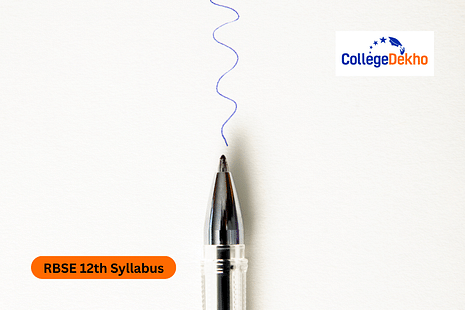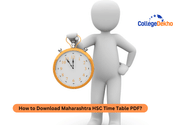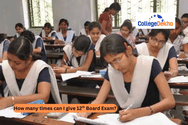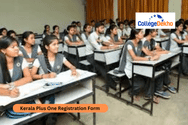RBSE 12th Syllabus 2025-26 PDF is available on the official website of RBSE at rajeduboard.rajasthan.gov.in. The syllabus consists of chapters that will be included in the board exams, along with their weightage. Go through the list of chapters in detail.


Never Miss an Exam Update
RBSE 12th Syllabus 2025-26 PDF is provided by the board on its official website. For all the subjects of Arts, Science, and Commerce streams, syllabus can be checked here in detail. By going through the syllabus PDF, students can check the chapters and topics included in them. They can divide the syllabus in smaller portions and complete the chapters in advance. This will provide them sufficient time for revision and make it possible for them to write answers for all types of questions. A PDF file is attached below for students to check the syllabus for each subject. In addition to the topics included in the syllabus, you can also check the marks allotted to the chapters and focus more on the chapters with high marks. For more details about the syllabus, continue reading the article. Also Read - RBSE Class 12 Exam Pattern 2025-26
RBSE 12th Syllabus 2025-26 PDF
You can download the latest PDF of the Class 12 Syllabus 2025-26 RBSE by clicking the direct link given below:
RBSE Class 12th Syllabus 2025-26
Refer to the latest Class 12 Syllabus 2025-26 RBSE for the different subjects included in the curriculum from the tables given below:
RBSE 12th Syllabus 2025-26 for English
Reading, writing, and the textbook will be the three sections of the English paper. The theory exam will be worth 80 marks, and students will have 3 hours and 15 minutes to complete all of the questions. For the RBSE Class 12 English Syllabus 2025-26 , see the table below.
| Sections | Topics |
|---|---|
| Reading | Two unseen passages (about 700-900 words in all) |
| Writing | Writing Compositions, Letters, Report writing |
| Flamingo Prose |
One extracts from different prose lessons included in Text Book (Approximately 100 words each) 4 comprehension questions testing local and global understanding and 2 questions on vocabulary—One testing the knowledge of similar words and the other testing the knowledge of the opposite word.
(ii) One out of two Long Answer Type Questions based on the text to test global comprehension are to be answered in about 80 words. (iii) Two Short Answer Type Questions based on the lessons to be answered in about 20-25 words |
| Flamingo Poetry |
(I) One out of two references to the context from the prescribed poems.
(ii) One out of two Long Answer Type Questions based on the text to be answered in 60 words. (iii) Two Short Answer Type Questions to be answered in 20-25 words. |
| Vistas |
One out of two Long Answer Type Questions based on Supplementary Reader to test comprehension and extrapolation of theme, character, and incidents about 60 words.
Two Short Answer Type Questions to be answered in about 20-30 words. Nine Multiple Choice Questions. |
RBSE 12th Syllabus 2025-26 for Chemistry
Check the RBSE Class 12 Chemistry Syllabus 2025-26 here:
Unit | Topics |
|---|---|
Unit 1: Solutions | Types of Solutions- Solid, Liquid and gaseous solutions- Expressing Concentration of Solutions- Solubility of solids in Liquids - Solubility of gases in Liquids-Henry's Law, Vapour Pressure of Liquid Solutions- Raoult's Law- Determination of Molecular masses using Colligative Properties, Ideal and Non-ideal Solutions, Colligative PropertiesRelative Lowering of Vapour Pressure-Elevation of Boiling point- Depression of freezing point - Osmosis and osmotic pressure - Reverse osmosis and water purification, Abnormal Molar Masses-Van't hoff factor. |
Unit 2: Electrochemistry | Electrochemical Cells, Galvanic Cells- Measurement of Electrode Potential- Standard Electrode Potential, Nernst Equation and its application to chemical cells- Equilibrium Constant from Nernst Equation- Electrochemical Cell and Gibbs Energy of the Reaction, Conductance of Electrolytic Solutions-Measurement of the Conductivity of Ionic Solutions-Molar Conductivity and Limiting Molar Conductivity Variation of Conductivity and Molar Conductivity with Concentration-Kohlrausch's Law, Electrolytic Cells - Electrolysis and Laws of Electrolysis- Products of Electrolysis, Primary BatteriesSecondary Batteries (Lead Accumulator) ,Fuel Cells, Corrosion. |
Unit 3: Chemical Kinetics | Rate of a Chemical Reaction (Average and Instantaneous), Factors Influencing Rate of a Reaction-Dependence of Rate on Concentration- Rate Expression and Rate constantOrder of a Reaction- Molecularity of a Reaction, Integrated Rate Equations- Zero Order Reactions- First Order Reactions- Half-Life of a Reaction, Temperature Dependence of the Rate of a Reaction-Effect of Catalyst, Collision Theory of Chemical ReactionsActivation energy-Arrhenious equation. |
Unit 4: d and f Block Elements | Position in the Periodic Table, Electronic Configurations of the d-Block Elements, General Properties of the Transition Elements (d-Block)-Physical Properties - Variation in Atomic and Ionic Sizes of Transition Metals- Ionisation Enthalpies- Oxidation States- Trends in the M2+/M Standard Electrode Potentials- Trends in the M3+/M2+ Standard Electrode Potentials- Trends of Stbaility of Higher Oxidation States- Chemical Reactivity and E Values- Magnetic Properties- Formation of Coloured Ions- Formation of Complex compounds- Catalytic Properties- Formation of Interstitial Compounds - Formation of Alloys, Preparation and Properties of K2 Cr2 O7 and KMnO4 , The Lanthanoids- Electronic Configurations, Atomic and Ionic Sizes- Lanthanoid Contraction and its Consequences- Oxidation States- General Characteristics- Chemical Reactivity,The Actinoids- Electronic Configurations- Ionic Sizes- Oxidation StatesGeneral Characteristics - Comparison with Lanthanoids, Some Applications of d- and fBlock Elements |
Unit 5: Coordination Compounds | Werner's Theory of Coordination Compounds, Definitions of Some Important Terms Pertaining to Coordination Compounds, Formulas and IUPAC Nomenclature of Mononuclear Coordination Compounds, Isomerism in Coordination CompoundsGeometric Isomerism- Optical Isomerism- Linkage Isomerism- Coordination IsomerismIonisation Isomerism- Solvate Isomerism, Bonding in Coordination Compounds- Valence Bond Theory-Magnetic Properties of Coordination compounds- Limitations of Valence Bond Theory- Crystal Field Theory- Colour in Coordination Compounds, Limitations of Crystal Field Theory, Bonding in Metal Carbonyls and Shapes, Importance and Applications of Coordination Compounds. |
Unit 6: Haloalkanes and Haloarenes | Classification- On the Basis of Number of Halogen Atoms- Compounds containing sp3 C–X Bond (X=F, Cl, Br,I)- Compounds containing sp2 C–X Bond, Nomenclature, Nature of C–X Bond, Methods of Preparation of Haloalkanes- From Alcohols- From HydrocarbonsFrom Halogen Exchange, Preparation of Haloarenes, Physical Properties, Chemical Reactions- Reactions of Haloalkanes- Optical Rotation - Mechanism of Nucleophilic Substitution Reactions- Reactions of Haloarenes, Polyhalogen Compounds-Dichloro methane (Methylene chloride)- Trichloromethane (Chloroform)- Triiodomethane (Iodoform)- Tetrachloromethane (Carbon tetrachloride) - Freons - p,p'- Dichlorodiphenyltrichloroethane (DDT). |
Unit 7: Alcohols, Phenols and Ethers | Alcohols- Nomenclature- Methods of preparation- Physical and Chemical properties ( of primary alcohols only)- Identification of Primary, Secondary and Tertiary alcoholsMechanism of Dehydration- Uses with sepecial reference to Methanol and Ethanol, Phenols- Nomenclature -Methods of preparation- Physical and Chemical properties - Acidic nature of Phenol- Electrophilic substitution reaction- Uses of Phenols, EthersNomenclature- Methods of preparation- Physical and Chemical properties- Uses |
Unit 8: Aldehydes, Ketones and Carboxylic Acids | Aldehydes and Ketones - Nomenclature - Nature and Structure of Carbonyl Compounds - Methods of Preparation - Physical and Chemical Properties- Mechanism of Nucleophilic addition Reaction-Reactivity of œ-Hydrogen in Aldehydes- Uses. Carboxylic Acids - Nomenclature - Acidic Nature and Structure - Methods of Preparation- Physical and Chemical Properties- Uses. |
Unit 9: Amines | Amine - Classification - Structure - Nomenclature- Methods of Preparation- Physical Chemical Properties- Basic Character of Amines , Diazonium Salts - Method of Preparation - Chemical Reactions- Importance in Synthesis of Aromatic Compounds |
Unit 10: Biomolecules | Carbohydrates- Classification (Aldoses and ketoses)-Monosaccharides (Glucose and Fructose) & D-L Configuration - Disaccharides (Sucrose , Lactose and Maltose) , Polysaccharides (Starch, Cellulose and Glycogen) Importance of Carbohydrates , Proteins- Amino Acids (Peptide Bond, Polypeptides and Proteins)- Structure of Proteins - Denaturation of Proteins, Enzymes- Mechanism of Enzyme Action , Vitamins- Classification and Functions, . Nucleic Acids (DNA and RNA) - Chemical Composition- Structure - Biological Functions, Hormones - Elementry Idea (Excluding Structure) |
RBSE 12th Syllabus 2025-26 for Physics
The following table lists the chapters and unit-wise topics for the RBSE Class 12 Physics Syllabus 2025-26 . There are three sections in the Physics exam: thirty for the practical, forty for theory, and fourteen for internal assessment.
Chapter | Topics |
|---|---|
Chapter 1: Electric Charges and Fields | INTRODUCTION, ELECTRIC CHARGE, CONDUCTORS AND INSULATORS, BASIC PROPERTIES OF ELECTRIC CHARGE- (Additivity of charges, Charge is conserved, Quantisation of Charge), COULOMB'S LAW, FORCES BETWEEN MULTIPLE CHARGES, ELECTRIC FIELD - (Electric field due to a system of charges, Physical significance of electric field), ELECTRIC FIELD LINES, ELECTRIC FLUX, ELECTRIC DIPOLE - (The field of an electric dipole - i. For points on the axis (ⅱ) For points on the equatorial plane, Physical significance of dipoles), DIPOLE IN A UNIFORM EXTERNAL FIELD, CONTINUOUS CHARGE DISTRIBUTION, GAUSS'S LAW, APPLICATIONS OF GAUSS'S LAW - (Field due to an infinitely long straight uniformly charged wire, Field due to a uniformly charged infinite plane sheet, Field due to a uniformly charged thin spherical shell). |
Chapter 2: Electrostatic Potential and Capacitance | INTRODUCTION, ELECTROSTATIC POTENTIAL, POTENTIAL DUE TO A POINT CHARGE, POTENTIAL DUE TO AN ELECTRIC DIPOLE, POTENTIAL DUE TO A SYSTEM OF CHARGES, EQUIPOTENTIAL SURFACES - (Relation between field and potential), POTENTIAL ENERGY OF A SYSTEM OF CHARGES, POTENTIAL ENERGY IN AN EXTERNAL FIELD-(Potential energy of a single charge, Potential energy of a system of two charges in an external field, Potential energy of a dipole in an external field), ELECTROSTATICS OF CONDUCTORS-(Inside a conductor electrostatic field is zero, At the surface of a charged conductor electrostatic field must be normal to the surface at every point, The interior of a conductor can have no excess charge in the static situation, Electrostatic potential is constant throughout the volume of the conductor and has the same value on its surface, Electric field at the surface of a charged conductor, Electrostatic shielding), DIELECTRICS AND POLARISATION, CAPACITORS AND CAPACITANCE, THE PARALLEL PLATE CAPACITOR, EFFECT OF DIELECTRIC ON CAPACITANCE, COMBINATION OF CAPACITORS - (Capacitors in series, Capacitors in parallel), ENERGY STORED IN A CAPACITOR (only Formula). |
Chapter 3: Current Electricity | INTRODUCTION, ELECTRIC CURRENT, ELECTRIC CURRENTS IN CONDUCTORS, OHM'S LAW, DRIFT OF ELECTRONS AND THE ORIGIN OF RESISTIVITY-(Mobility), LIMITATIONS OF OHM'S LAW, RESISTIVITY OF VARIOUS MATERIALS, TEMPERATURE DEPENDENCE OF RESISTIVITY, ELECTRICAL ENERGY- POWER, CELLS, EMF, INTERNAL RESISTANCE, CELLS IN SERIES AND IN PARALLEL, KIRCHHOFF'S RULES, WHEATSTONE BRIDGE. |
Chapter 4: Moving Charges and Magnetism | INTRODUCTION, MAGNETIC FORCE - (Sources and fields, Magnetic Field - Lorentz Force, Magnetic force on a current carrying conductor), MOTION IN A MAGNETIC FIELD, MAGNETIC FIELD DUE TO A CURRENT ELEMENT - BIOT SAVART LAW, MAGNETIC FIELD ON THE AXIS OF A CIRGULAR CURRENT LOOP, AMPERE'S CIRCUITAL LAW, THE SOLENOID, FORCE BETWEEN TWO PARALLEL CURRENTS - THE AMPERE, TORQUE ON CURREN LOOP - MAGNETIC DIPOLE- (Torque on a rectangular current loop in a uniform magnetic field, circular current loop as a magnetic dipole), THE MOVING COIL GALVANOMETER. |
Chapter 5: Magnetism and Matter | INTRODUCTION, THE BAR MAGNET - (The magnetic field lines, Bar magnet as an equivalent solenoidonly qualitative study, The dipole in a uniform magnetic field, The electrostatic analog), MAGNETISM AND GAUSS'S LAW, MAGNETISATION AND MAGNETIC INTENSITY, MAGNETIC PROPERTIES OF MATERIALS - (Diamagnetism, Paramagnetism, Ferromagnetism). |
Chapter 6: Electromagnetic Induction | INTRODUCTION, THE EXPERIMENTS OF FARADAY AND HENRY, MAGNETIC FLUX, FARADAY'S LAW OF INDUCTION, SLENZ'S LAW AND CONSERVATION OF ENERGY, MOTIONAL ELECTROMOTIVE FORCE, INDUCTANCE - (Mutual Inductance, self-Inductance), AC GENERATOR |
Chapter 7: Alternating Current | INTRODUCTION, AC VOLTAGE APPLIED TO A RESISTOR, REPRESENTATION OF AC CURRENT AND VOLTAGE BY ROTATING VECTORS - PHASORS, AC VOLTAGE APPLIED TO AN INDUCTOR, AC VOLTAGE APPLIED TO A CAPACITOR, AC VOLTAGE APPLIED TO A SERIES LCR CIRCUIT - (Phaser - diagram solution, Resonance), POWER IN AC CIRCUIT: THE POWER FACTOR, TRANSFORMERS. |
Chapter 8: Electromagnetic Waves | INTRODUCTION, DISPLACEMENT CURRENT, ELECTROMAGNETIC WAVES- (sources of electromagnetic waves, Nature of electromagnetic waves), ELECTROMAGMETIC SPECTRUM- (Radio waves, Microwaves, Infrared waves, visible rays, ultraviolet rays, x-rays, Gamma rays). |
Chapter 9: Ray Optics and Optical Instruments | INTRODUCTION, REFLECTION OF LIGHT BY SPHERICAL MIRRORS- (Sign convention, Focal length of spherical mirrors, The mirror equation), REFRACTION, TOTAL INTERNAL REFLECTION (Total internal reflection in nature and its technological applications - i. Prism ii. Optical fibers), REFRACTION AT SPHERICAL SURFACES AND BY LENSES- (Refraction at a spherical surface, Refraction by a lens, Power of a lens, Combination of thin lenses in contact), REFRACTION THROUGH A PRISM, OPTICAL INSTRUMENTS - (The microscope, Telescope). |
Chapter 10: Wave Optics | INTRODUCTION, HUYGENS PRINCIPLE, REFRACTION AND REFLECTION OF PLANE WAVES USING HUYGENSS PRINCIPLE – (Refraction of a plane Wave, Refraction at a rarer medium, Reflection of a plane wave by a plane surface), COHERENT AND INCOHERENT ADDITION OF WAVES, INTERFERENCE OF LIGHT WAVES AND YOUNG’S EXPERIMENT- (only formula of bright and dark fringes), DIFFRACTION - (only qualitative study)- (The Single slit, seeing the Single slit diffraction pattern), POLARISATION. |
Chapter 11: Dual Nature of Radiation and Matter | INTRODUCTION, ELECTRON EMISSION, PHOTOELECTRIC EFFECT – (Hertz’s observations, Hallwach’s and Lenard’s observations), EXPERIMENTAL STUDY OF PHOTOELECTRIC EFFECT- (Effect of intensity of light on photocurrent, Effect of potential on photoelectric current, Effect of frequency of incident radiation on stopping potential), PHOTOELECTRIC EFFECT AND WAVE THEORY OF LIGHT, EINSTEIN’S PHOTOELECTRIC EQUATION: ENERGY QUANTUM OF RADIATION, PARTICLE NATURE OF LIGHT: THE PHOTON, WAVE NATURE OF MATTER. |
Chapter 12: Atoms | INTRODUCTION, ALPHA-PARTICLE, SCATTERING AND RUTHERFORD'S NUCLEAR MODEL OF ATOM- (Alpha- Particle trajectory, Electron orbits), ATOMIC SPECTRA, BOHR MODEL OF THE HYDROGEN ATOM (only formula of radius of nth orbit)- (Energy levels), THE LINE SPECTRA OF THE HYDROGEN ATOM (Only qualitative Study), DE BROGLIE'S EXPLANATION OF BOHR'S SECOND POSTULATE OF QUANTISATION. |
Chapter 13: Nuclei | INTRODUCTION, ATOMIC MASSES AND COMPOSITION OF NUCLEUS- (Discovery of Neutron), SIZE OF THE NUCLEUS, MASS-ENERGY AND NUCLEAR BINDING ENERGY - (Mass-Energy, Nuclear binding energy), NUCLEAR FORCE, RADIOACTIVITY, NUCLEAR ENERGY - (Fission, Nuclear fusion - energy generation in stars, controlled thermo- nuclear fusion) |
Chapter 14: Semiconductor Electronics: Materials, Devices and Simple Circuits | INTRODUCTION, CLASSIFICATION OF METALS, CONDUCTORS AND SEMICONDUCTORS – (On the basis of conductivity, on the basis of energy bands), INTRINSIC SEMICONDUCTOR, EXTRINSIC SEMICONDUCTOR- (n-type semiconductor, p-type semiconductor), p-n Junction- (p-n junction formation), SEMICONDUCTOR DIODE - (p-n junction diode under forward bias, p-n junction diode under reverse bias), APPLICATION OF JUNCTION DIODE AS A RECTIFIER. |
RBSE 12th Syllabus 2026 for Biology
RBSE Class 12 Biology Syllabus 2025-26 is provided in the table below with the chapter-wise marking scheme. The Biology exam contains 56 marks for theory, 30 marks for practical, and 14 marks for internal evaluation.
| Chapters | Particulars |
| Sexual Reproduction in Flowering Plants | Flower- A Fascinating organ of Angiosperms, Pre-fertilization: structures and events, Stamens, Microsporangium and Pollen grain, The pistil, Megasprorangium and Embryosac, Pollination, Double fertilisation, Post- Fertilisation : structures and events- Endosperm, Embryo, Seed , Apomixis and Polyembryony. |
| Human Reproduction | The Male Reproductive System , The Female Reproductive System , Gametogenesis , Menstrual Cycle, Fertilisation and Implantation ,Pregnancy and Embryonic Development , Parturition and Lactation. |
| Reproductive Health | Reproductive Health–Problems and Strategies , Population Stabilisation and Birth Control, Medical Termination of Pregnancy, Sexually Transmitted infections, Infertility. |
| Principles of Inheritance and Variation | Mendel’s Laws of Inheritance , Inheritance of One Gene- Law of Dominance, Law of Segregation (Incomplete dominance, Co-dominance) Inheritance of Two Genes- Law of Independent Assortment, Chromosomal Theory of Inheritance, Linkage and Recombination, Polygenic Inheritance, Pleiotropy, Sex Determination- Sex Determination in Honey Bee and Humans, Mutation, Genetic Disorders- Pedigree Analysis, Mendelian Disorders- (Colour Blindness, Haemophilia, Sickle-cell anaemia, Phenylketonuria, Thalassemia, Chromosomal Disorders). |
| Molecular Basis Of Inheritance | The DNA -Structure of Polynucleotide chain, Packaging of DNA helix, The Search for Genetic Material- The Genetic material is DNA, Properties of Genetic material, RNA world, Replication - The Experimental proof , The Machinery and the Enzymes, Transcription - Transcription unit, Transcription unit and the Gene, Types of RNA and the process of transcription, Genetic Code- Mutation and Genetic code, tRNA- The adapter molecule, Translation , Regulation of Gene Expression- The Lac Operon, Human Genome Project- Salient features of Human genome , Applications and future challenges, DNA Fingerprinting. |
| Evolution | Origin of Life, Evolution of Life Forms – A theory, Evidences for Evolution, Adaptive Radiation, Biological Evolution, Mechanism of Evolution , Hardy – Weinberg Principle, A Brief Account of Evolution, Origin and Evolution of Man. |
| Human Health and Disease | Common Diseases in Humans, Immunity - Innate Immunity, Acquired Immunity, Active and Passive Immunity, Vaccination and Immunisation, Allergies, Auto Immunity, Immune System in the body , AIDS , Cancer, Drugs and Alcohol abuse- Adolescence and Drug/Alcohol abuse , Addiction and dependence , effects of drug/alcohol abuse , Prevention and control. |
| Microbes in Human Welfare | Microbes in Household Products, Microbes in industrial products- Fermented beverages, Antibiotics, Chemicals, Enzymes and other bioactive molecules, Microbes in Sewage Treatment, Microbes in Production of Biogas, Microbes as Biocontrol Agents , Microbes as Biofertilisers. |
| Biotechnology: Principles and Processes | Principles of Biotechnology, Tools of recombinant DNA Technology-Restriction Enzymes, Cloning vectors, Competent host (For Transformation with Recombinant DNA) , Processes of Recombinant DNA Technology-Isolation of the Genetic material (DNA), Cutting of DNA at specific locations, Amplification of Gene of interest using PCR, Insertion of Recombinant DNA into the Host Cell/Organism, Obtaining the foreign Gene product, Downstream processing. |
| Biotechnology and its Applications | Biotechnological applications in Agriculture, Biotechnological applications in Medicine-Genetically engineered Insulin, Gene Therapy, Molecular diagnosis, Transgenic animals, Ethical issues. |
| Organisms and Population | Populations - Population Attributes, Population Growth, Life History Variation, Population Interactions. |
| Ecosystem | Ecosystem–Structure and Function , Productivity , Decomposition , Energy Flow, Ecological Pyramids. |
| Biodiversity and Conservation | Biodiversity- Biodiversity on Earth and in India, Patterns of Biodiversity, The importance of species diversity to the Ecosystem, Loss of Biodiversity, Biodiversity Conservation. |
| Total | 56 |
RBSE 12th Syllabus 2025-26 for Mathematics
The Mathematics syllabus consists of 100 marks, divided into an 80-mark theory paper and a 20-mark practical/viva. Both theory and practical exams should be passed by students. Refer to the following table for the RBSE Class 12 Mathematics Syllabus 2025-26 for
| Units | Chapters | Topics |
|---|---|---|
| Relations and Functions | Relations and Functions | Introduction , Types of relations, Types of functions, Composition of Functions and Invertible function. |
| Inverse Trigonometric Functions | Inverse Trigonometric Functions | Introduction, Basic Concepts , Properties of Inverse Trigonometric Functions |
| Algebra | Matrices | Introduction, Matrix, Types of matrices, Operations on Matrices, Transpose of a Matrix, Symmetric and Skew Symmetric Matrices, Invertible Matrices . |
| Calculus | Continuity And Differebtiability | Introduction, Continuity, Differentiability, Exponential and Logarithmic Functions, Logarithmic Differentiation, Derivatives of Functions in Parametric Forms ,Second Order Derivative |
| Applications of Derivatives | Introduction, Rate of change of Quantities ,Increasing and Decreasing Functions , maxima and Minima. | |
| Integrals | Introduction, Integration as inverse process of differentiation, Methods of Integration, Integrals of Some Particular Functions ,Integration by Partial Fractions, Integration by Parts, Definite Integral, Fundamental Theorem of Calculus, Evaluation of Definite Integrals by Substitution, Some Properties of Definite Integrals. | |
| Applications of the Integrals | Introduction, area under simple curves | |
| Differential Equations | Introduction , Basic Concepts, General and Particular Solutions of a differential Equation, Methods of solving first order, first degree differential Equations. | |
| Vectors and three-dimensional geometry | Introduction, Some Basic Concepts, Types of Vectors, Addition of Vectors, Multiplication of a Vector by a Scalar, Product of Two Vectors. | |
| Three-Dimensional Geometry | Introduction, Direction Cosines and Direction Ratios of a Line, Equation of a Line in Space, Angle between two lines, Shortest Distance between two lines. | |
| Linear Programming | Linear Programming | Introduction, Linear programming problems and its mathematical formulation |
| Probability | Probability | Introduction Probability, Conditional probability, Multiplication Theorem on probability, Independent Events , Baye’s theorem. |
RBSE 12th Syllabus 2025-26 for Economics
Microeconomics and Macroeconomics are the two components of the syllabus. The unit-wise marks distribution may be found in the RBSE Class 12 Economics Syllabus 2025-26 below:
Part A: Macroeconomics | ||
|---|---|---|
Unit 1: Macroeconomics | Chapter 1. INTRODUCTION Chapter 2. NATIONAL INCOME ACCOUNTING | Emergence of Macroeconomics, Context of the Present Book of Macroeconomics, Basic concepts in macroeconomics, Circular flow of income (two sector model); Methods of calculating National Income - Value Added or Product method, Expenditure method, Income method. Factor cost, basic prices and market prices, macreoeconomic identities, Real and Nominal GDP, GDP and Welfare. |
Unit 2: Money and Banking | Chapter 3. Money and Banking | Functions of Money, demand for money, supply of money, Money creation by the banking system : Balance Sheet of a Fictional Bank, Limits to Credit Creation and Money Multiplier, policy tools to control money supply |
Unit 3: Income and Employment | Chapter 4. Determination of Income and Employment | Aggregate demand and its components-consumption, investment, determination of Income in two sector model, Determination of equilibrium with price level, fixed effect of an autonomous change in aggregate |
Unit 4: Government Budget | Chapter 5. Government Budget and the Economy | Government budget - meaning, objectives and its components, Objectives of government budget, Classification of receipts , Classification of expenditure,Balanced, surplus, deficit Budget. Measures of government deficit. |
Unit 5: Open Economy | Chapter 6. Open Economy-Macroeconomics | Balance of payments, current account, capital account, balance of payments surplus and deficit. Foreign exchange market, Foreign exchange rate, Determination of exchange rate , merits and demerits of flexible and fixed exchange rate systems, managed floating. |
Part B: Introductory Microeconomics | ||
Unit 1: Introductory Microeconomics | Chapter 1. INTRODUCTION | A Simple Economy , Central Problems of an Economy , Organisation of Economic Activities ,The Centrally Planned Economy,The Market Economy, Positive and Normative Economics, Microeconomics and Macroeconomics. |
Unit 2: CONSUMER BEHAVIOUR | Chapter 2. THEORY OF CONSUMER BEHAVIOUR | Utility, Cardinal Utility Analysis, Ordinal Utility Analysis, The Consumer’s Budget, Budget Set and Budget Line, Changes in the Budget Set, Optimal Choice of the Consumer, Demand, Demand Curve and the Law of Demand, Deriving a Demand Curve from Indifference Curves and Budget Constraints, Normal and Inferior Goods, Substitutes and Complements, Shifts in the Demand Curve , Movements along the Demand Curve and Shifts in the Demand Curve, Market Demand, Elasticity of Demand, Elasticity along a Linear Demand Curve, Factors Determining Price Elasticity of Demand for a Good, Elasticity and Expenditure. |
Unit 3: CONCEPTS of PRODUCTION AND COSTS | Chapter 3. PRODUCTION AND COSTS |
Production Function. The Short Run and the Long Run. Total Product, Average
|
Unit 4: PERFECT COMPETITION | Chapter 4: THE THEORY OF THE FIRM UNDER PERFECT COMPETITION Supply.Chapter 5: MARKET EQUILIBRIUM Chapter 6. NON-COMPETITIVE MARKETS |
Perfect Competition: Defining Features, Revenue, Profit Maximization, The Profit Maximization Problem: Graphical Representation, Supply Curve of a Firm, Short Run Supply Curve of a Firm. Long Run Supply Curve of a Firm, The Shut Down Point, The Normal Profit and Break-even Point, Determinants of a Firm’s Supply Curve,
|
Equilibrium, Excess Demand, Excess Supply, Market Equilibrium: Fixed Number of Firms, Market Equilibrium: Free Entry and Exit, Applications, Price Ceiling Price Floor. Simple Monopoly in the Commodity Market, Market Demand Curve is the Average Revenue Curve, Total, Average, and Marginal Revenues, Marginal Revenue and Price Elasticity of Demand, Short Run Equilibrium of the Monopoly Firm, Other Non-perfectly Competitive Markets, Monopolistic Competition, Oligopoly | ||
RBSE 12th Syllabus 2025-26 for Business Studies
The subject of business studies is divided into eight units in the RBSE class 12 syllabus. In the table below, you'll find the RBSE Class 12 Business Studies Syllabus 2025-26 :
| Units | Topics |
|---|---|
| Principles And Functions of Management | |
| Nature and Significance of Management | Introduction and Definition, Concept of Management, Objectives of Management, Characteristics of Management , importance and Nature of Management. Effectiveness versus efficiency. Management as Art, Management as Science, Management as Profession, Characteristics of profession. Levels of Management, Functions of management- Planning, organising, staffing, directing, Controlling , Coordination-Coordinations the essence of management, Definitions, Characteristics and importance of Coordination. Management in the 21st century |
| Principles of Management | Introduction, Principles of Management-The Concept, Nature and Significance of Principles of Management . Taylor's Scientific Management -Principles and Techniques of Scientific Management , Feyol`s Principles of Management, Difference between unity of command and unity of Direction, Feyol versus Taylor-A Comparison. |
| Business Environment | Introduction, Meaning of Business Environment, Importance of Business Environment Dimension of Business Environment- Economic, Social ,Technological, Political, Legal. Economic Environment in India- Liberalisation, Privatisation and Globalisation. Demonetisation- Features and Impact |
| Planning | Introduction, Concept of Planning, Importance of Planning, Features of Planning, Limitation of Planning ,Planning Process, Types of Plans Objectives- Strategy, Policy, Procedure, Method, Rule, Programme and Budget |
| Organizing | Introduction -Meaning, Definition of Organising ,Steps in the Process of Organising, Importance of Organising. Organisation Structure- Types of Organization Structures- Functional Structure, Divisinal Structure Comparative view- Functional Structure and Divisinal Structure . Formal and Informal Organisation, A comparative view - Formal and Informal organisation Delegation - Elements and overview of the elements of Delegation, Importance of Delegation. Centralisation and Decentralisation, Decentralisation- Meaning and Importance, Delegation and Decentralisation-A comparative view |
| Staffing | Introduction, Meaning and Importance of staffing, Staffing as part of human resource management, Evolution of Human Resource Management, Staffing of Process. Aspects of staffing- Recruitment, Sources of Recruitment-Internal and External Selection. Process of Selection- Training and development Importance of Training and Development. Benefits to organisation & employee Training development and education , Training Method:- On the JOB, Off the Job |
| Directing | Directing- Introduction, Meaning, Characteristics , Importance, Principles and Elements of Directing, Supervision- Importance of Supervision Motivation -Meaning, Definition, features, Motivation Process,Importance of Motivation Maslow`s need Hierarchy theory of motivation,Financial and Non-Financial Incentives Leadership-Definition ,Features, Importance of leadership and Leadership Style. Communication- Element and Importance of Communication process, Formal and Informal Communication Process, Grapvine Network, Barriers to Communication, Improving Communication Effectiveness |
| Controlling | Controlling- Meaning , Importance and Limitation of Controlling, Relationship between planning and Controlling, Controlling Process |
| Business Finance and Marketing | |
| Financial Management | Introduction, Meaning of Business Finance, Financial management, Importance and Objectives, Financial Decisions-1. Investment decision. Factors affecting capital budgeting decision 2. Financing decision , Factors affecting financing decision 3.Dividend decision, Factors Affecting Dividend Decision Financial Planning, Concept and Importance of Financial Planning. Capital Structure- Concept and Factors affecting the choice of capital Structure, Management of Fixed capital. Fixed and working Capital - Concept and Factors affecting their Requirements. |
| Marketing | Meaning and features of Marketing, Marketing Management, Philosophies Marketing management, Differences in the marketing management philosophies Concept of Marketing- The production Concept ,The Product , The Selling, The marketing , The Social Marketing, Function of Marketing, Marketing mix, Products, Classification of products, Branding, Characterstistics of good brand name , Packaging-Levels, Importance and functions , Labelling and function of labelling, Pricing - Factors affecting price determination, Physical Distribution-Components of Physical Distribution Promotion, Promotion mix Meaning and Feature of advertising, Merits of Advertising, Objections to Advertising, Personal selling- Meaning , Feature and merits, Role of personal selling. Difference between advertising and personal selling, Sales Promotion, Merits and Limitation of Sales promotion, Commonly used sales promotion activities, Public Relation, Role of Public Relation. |
| Consumer Protection | Introduction, Importance of Consumer Protection- From consumer and business point of view, Need for Consumer protection, Who is Consumer ? The Consumer Protection Act 2019, Rights and Responsibilities of Consumer, Ways and means of consumer protection, Redressal Agencies under the Consumer Protection ACT, Relief available |
RBSE 12th Syllabus 2026 for Accountancy
Refer to the table below to learn more about the RBSE Class 12 Accountancy Syllabus 2025-26 :
| Parts | Units | Topics |
|---|---|---|
| Part A | I. Accounting for Partnership: Basic Concepts | Nature of Partnership - Meaning and features Partnership Deed- Meaning , Types , Contents of partnership deed, Provision of partnership act relevant for Accounting, Special Aspects of Partnership Accounts , Maintenance of Capital Accounts of Partners - Fixed capital method, Fluctuating Capital mehod and distinction Between both of methods Distribution of Profit among Partners- Profit and loss appropriation account, Journal entries of adjustments as interest on capital, Interest on drawing, Salary, Commission and other benifits. Guarantee of Profit to a Partner , Past Adjustments- Relating to interest on capital , interest and drawing , Salary, Commission , Profit sharing ratio and other benefits. |
| II. Reconstitution of a Partnership Firm – Admission of a Partner | Meaning & Modes of Reconstitution of a Partnership Firm Admission of a New Partner New Profit Sharing Ratio Sacrificing Ratio Goodwill - Meaning, Factors affecting the value of Goodwill , Need of Valuation ,Mehtods of Valuation, Treatment of Goodwill, Hidden Goodwill Adjustment for Accumulated Profits and Losses Adjustment of Capitals, Revaluation of Assets and Reassessment of Liabilities and Treatment of accounting, Change in Profit Sharing Ratio among the Existing Partners | |
| III. Reconstitution of a Partnership Firm Retirement/Death of a Partner | Ascertaining the Amount Due to Retiring/Deceased Partner New Profit Sharing Ratio Gaining Ratio Treatment of Goodwill- When Goodwill account doesnot appear in the books, When Goodwill account appears in the books, Hidden Goodwill. Accouting for Adjustment for Revaluation of Assets and Liabilities Adjustment of Accumulated Profits and Losses, When a partner retires in the middle of the financial year Disposal of Amount Due to Retiring Partner Adjustment of Partners’ Capitals Accounting on Death of a Partner. | |
| IV. Dissolution of Partnership | Dissolution of Partnership and its ways Dissolution of a Firm - ways, distinction between dissolution of the partnership and partnership firm, Settlement of Accounts Accounting Treatment -journal entry, Preparing realisation account, partners capital account, Bank account/ Cash account | |
| Company Accounts and Analysis of Financial Statements | ||
| Part B | I. Accounting for Share Capital | Meaning and Features of a Company Kinds of Companies Share Capital of a Company-Categories of share capital. Nature and Classes of Shares- Preference shares , Equity share Issue of Shares -Procedure of issue of shares. Accounting Treatment-Issue of shares, Forfeiture and Reissue of shares |
| II. Issue and Redemption of Debentures | Meaning of Debentures and Bond Distinction between Shares and Debentures Types of Debentures Issue of Debentures- For Cash at par, At premium ,At a discount Over Subscription Issue of Debentures for Consideration other than Cash Issue of Debentures as a Collateral Security Terms of Issue of Debentures Interest on Debentures- Accounting treatment Writing off Discount/Loss on Issue of Debentures | |
| III. Financial Statements of a Company | Meaning and Nature of Financial Statements Objectives of Financial Statements Types of Financial Statements -Format and content of balance sheet, Statement of Profit and loss as per schedule Uses and Importance of Financial Statements Limitations of Financial Statements. | |
| IV. Accounting Ratios | Meaning of Accounting Ratios Objectives of Ratio Analysis Advantages of Ratio Analysis Limitations of Ratio Analysis Types of Ratios- Traditional Classification and Functional classification Liquidity Ratios Solvency Ratios Activity (Turnover) Ratio Profitability Ratios | |
| V. Cash Flow Statement | Objectives and meaning of Cash Flow Statement Benefits of Cash Flow Statement Cash and Cash Equivalents Cash Flows 06 Classification of Activities for the Preparation of Cash Flow Statement-Operating, Investing and Financing Ascertaining Cash Flow from Operating Activities - Direct and Indirect mehod Ascertainment of Cash Flow from Investing and Financing Activities Preparation of Cash Flow Statement | |
RBSE 12th Syllabus 2025-26 for Political Science
Students should prepare for all subjects in the Arts streams to improve their RBSE 12th Arts results. One of the key subjects in this stream is Political Science. The following is the RBSE Class 12 Political Science Syllabus 2025-26 :
- Part A: Contemporary World-Politics (40 Marks)
| Chapters | Topics |
|---|---|
Chapter 1: The End Of Bipolarity | The Soviet System, Gorbachev and the Soviet Union disintegration, Disintegration of the Soviet Union, Consequences of disintegration, Shock Therapy in post-communist regimes, Consequences of shock therapy, Tension and Conflicts, India and post communist countries, India and the USSR. |
Chapter 2: Contemporary Centers Of Power | European Union, Associations of South East Asian Nations (ASEAN), the Rise of the Chinese Economy, India –China Relations, Japan, South Korea. |
Chapter 3: Contemporary South Asia | South Asia, The Military and Democracy in Pakistan, Democracy in Bangladesh, Monarchy and Democracy in Nepal, Ethnic Conflict and Democracy in Sri lanka, India-Pakistan Conflicts, India and its other neighbours, Peace and Cooperation. |
Chapter 4: International Organisations | Importance of International Organizations, Evolution of the UNO, Reform of the UNO after the Cold War, Reform of Structures and Process, Jurisdiction of the UNO, India and the UNO Reforms, The UNO in a Unipolar World, IMF, World Bank, WTO, IAEA, Concerning NGO – Amnesty International, Human Right Watch. |
Chapter 5: Security in the Contemporary World | Security, Traditional Notions: External, Traditional Notions: Internal, Traditional Security and Cooperation, Non Traditional Notions, New Sources of threats, Human rights, India's Security Strategy. |
Chapter 6: Environment and Natural Resources | Environmental Concerns in Global Politics, The protection of Global Commons, Common but Differentiated Responsibilities, Common Property, India`s stand on Environmental Issues, Environmental Movements: One or Many, Resource Geopolitics, The Indigenous Peoples and Their Rights, Sacred Groves in India. |
Chapter 7: Globalisation | The Concept of Globalisation, Causes of Globalisation, Consequences of Globalisation, Political Consequences, Economic Consequences, Cultural Consequences, India and Globalisation, Resistance to Globalisation, India and Resistance to Globalisation. |
- Part B: Politics of India Since Independence (40 Marks)
Chapters | Topics |
|---|---|
Chapter 8: Challenges of Nation Building | Challenges for the new nation, Three Challenges, Partition: Displacement and rehabilitation, Process of Partition, Consequences of Partition, Integration of Princely States Hyderabad Princely State, Manipur Princely State, Government's Approach, Reorganisations of States, Creation of New States |
Chapter 9: Era of One-Party Dominance | Challenge of Building democracy, Congress dominance in the first three general elections, Nature of Congress dominance, Emergence of opposition parties, Socialist Party, The Communist Party of India, Bhartiya Jana-Sangh. |
Chapter 10: Politics of Planned Development | Political Contestation, The Early Initiatives, The first five year plan, Rapid Industrialisation, Decentralized planning, Planning Commission NITI Ayog. |
Chapter 11: India’s External Relations | International Context, The policy of Non- Alignment, Nehru’s Role, Distance From Two Camps, Afro-Asian Unity, Peace and Conflict With China, The Chinese Invasion-1962, Tibet, Wars And Peace With Pakistan, Bangladesh War-1971, Kargil Confrontation, India's Nuclear Policy, India’s Nuclear Programme. |
Chapter 12: Challenge to and Restoration of The Congress System | Challenge of Political Succession, Fourth General Elections-1967, Electoral Verdict, Non-Congressism, Coalitions, Defection, Indira vs The Syndicate, Presidential Election-1969, Split in The Congress, The 1971 Election And Restoration of Congress, Abolition of Privy Purse. |
Chapter 13: The Crisis of the Democratic Order | Background to Emergency, Gujarat and Bihar Movements, Conflict with Judiciary, Declaration of Emergency, Lessons of the Emergency, Politics After Emergency, Lok Sabha Election-1977. |
Chapter 14: Regional Aspirations | Region and Nation, Indian Approach, Areas of Tension, Jammu & Kashmir, Roots of The Problem, External and Internal Disputes, Punjab, Political Context, Cycle of Violence, Road to Peace, The North-East Demands for Autonomy, Secessionist Movements, Movements Against Outsiders, Accommodation And National Integration, Sikkim’s Merger, Goa’s Liberation, Dravidian Movement. |
Chapter 15: Recent Developments in Indian Politics | Concept of The 1990’s, Era of Coalitions, Decline of Congress, Alliance Politics, Political Rise of other Backward Classes, The Mandal Commission, Political Fallouts, Communalism, Secularism, Democracy, Ayodhya Dispute, Demolition And After, Emergence of a New Consensus. |
RBSE 12th Syllabus 2025-26 for Geography
The Geography syllabus includes Part A and Part B. Check the RBSE Class 12 Geography Syllabus 2025-26 here:
Units | Topics |
|---|---|
| Fundamentals of Human Geography | Nature of Human Geography, Definitions of Human Geography, Naturalization of Human and Humanization of Nature. |
| THE WORLD POPULATION: DISTRIBUTION, DENSITY, AND GROWTH | patterns of population distribution in the world, density of population, factors influencing the distribution of Population, Population growth, components of population change-births, deaths and migration, demographic transition, population control measures. |
| Human Development | Growth and development, The four pillars of Human development, Approaches to human development: Income approach; Welfare approach; Minimum needs approach; capabilities approach. measuring human development. The human development index (HDI). International comparisons. |
| Primary activities | Hunting and gathering, Pastoralism: Nomadic herding, Commercial livestock rearing. Agriculture: subsistence agriculture primitive subsistence agriculture. intensive subsistence agriculture. plantation agriculture. Extensive Commercial grain cultivation. Mixed farming. Dairy farming. Mediterranean agriculture. Market gardening and Horticulture. co-operative farming. collective farming. Mining: factors affecting mining activity. methods of mining. |
| Secondary activities | Manufacturing, Characteristics of modern large scale manufacturing. Skill specialization, mechanization, organizational structure and stratification. Technological innovation. Uneven geographical distribution, Access to market. Access to raw material Access, access to labour supply, access to Sources of Energy. Accessibility to transport and communication facilities, Government policy. Accessibility to agglomeration Economics/Links between industries, Classification of manufacturing industries -Size based industries, Raw materials based industries, Production/Product based industries. Ownership industries,( Freelance ) Foot loose industries . |
| Tertiary & Quaternary activities | Types of tertiary activities, trade and commerce, retail trading, wholesale trading, transport, communication, telecommunication, services, people engaged in tertiary activities, some selected examples –tourism, tourism region, Tourist Attractions, Medical services for overseas patients in India, quaternary activities. Quinary activities, outsourcing, the digital divide. |
| Transport & Communication | Land Transport- Roads, Borderroads, railways- trans–continental railways- Trans–Siberian, TransCanadian, the union and pacific railway, the Australian trans–continental Railway, the orient express. water transport- sea routes- the northern Atlantic sea route, the mediterranean–indian ocean sea route, the cape of good hope sea route, the southern Atlantic sea route, the north pacific sea route, the south pacific sea route, coastal shipping. Shipping canals- the Suez Canal, the Panama Canal. Inland waterways- the Rhine waterways, the Volga waterway, the Danube waterway, the great lakes – st. lawrence seaway, the mississippi waterways. Air transport- inter-continental air routes. Pipelines, Communications- satellite communication, cyber space – internet. |
| International trade | History of international trade, why international trade existed, basis of international trade, balance of trade, free trade situation, dumping, world trade organization, matters related to international trade, port, type of ports- classified according to the types of traffic which they handle, depending on location, on the basis of specialized functions. |
| Unit 2 - People and Economy | |
| Population, Distribution of Density, Growth and Composition | Distribution of density of population, Growth of Population,regional variations in population growth, population composition - rural-urban composition, linguistic composition and linguistic classification, religious composition, composition of working population. Occupatiolnal Categories. |
| Human Settlements | Rural settlements, The basic differences between rural and urban settlements, types of rural settlements: • Clustered, agglomerated or nucleated,•Semi-clustered or fragmented, Hamleted, and Dispersed or isolated., urban settlements: Ancient Towns, Medieval Towns and Modern Town. Urbanisation in India Functional Classification of Towns, Smart cities Mission |
| Land Resources and Agriculture | Land Use Categories, land use change in India, Common Property Resources, Agricultural land use in India, Cropping Seasons in India, Types of Farming, Foodgrains: Rice, Wheat, Jowar Maize, Bajra, Pulses, Gram, Tur (Arhar) Fibrous crops: Cotton and Jute , Other crops: Sugarcane, Tea and Coffee, oilseeds, Agricultural development in India, increase in agricultural production and development of technology, problems of Indian Agriculture. |
| Water resources | Water resources of India water demand and utilization, water quality depletion, water conservation and management, water pollution prevention, water recycling and reuse, watershed management, rainwater harvesting, watershed development: a reality Study, Indian National Water Policy, 2002, Jal Kranti Abhiyan (2015 -16). |
| Mineral and Energy Resources | Types of Mineral Resources, Distribution of Minerals in India: Ferrous Mineral: Iron-Ore, Copper, Bauxite, Manganese Non-ferrous Minerals. Non-metallic Minerals Energy Resources: Conventional Sources of Energy, Unconventional Energy Sources, Conservation of Mineral Resources. |
| Planning and Sustainable Development in Indian Context | Approches to Planning target area planning, hilly area development program, drought prone area development program, case study - coordinated tribal development program in Bharmour region, case study - Indira Gandhi Canal Command Area, sustainable nutritional development, promoting sustainable nutritional development remedy . |
| Transport and Communication | Major means of transport- Land Transport: Road Transport: Rail Transport, Water Transport, Inland Waterways, Ocean Routes, Air Transport, Oil & Gas Pipeline, Communication Network-Personal Communication System and Mass Communication System. |
| International Trade | Changing Pattern of the Composition of Indias Exports, Changing Pattern of the Composition of Indias Import, Direction of trade, Sea ports as gateways of International trade. |
| Geographical Perspective on Selected Issues and Problems | Environmental pollution: water pollution, air pollution, land pollution, noise pollution. Urban Waste Disposal Case Study- A Role Model of Restore the ecology and safeguard. Human health in Daurala. |
RBSE 12th Syllabus 2025-26 for History
The units and chapter-wise marking scheme for the RBSE Class 12th History Syllabus 2025–26 is listed below.
| Units | Chapters | Marks Allotment |
| Themes in Indian History, Part I | Bricks, Beads and Bones - The Harappan Civilisation | Beginnings, Subsistence Strategies –Agricultural technologies, Mohenjodaro-A Planned Urban Centre, Laying out drains, Domestic architecture, The Citadel,Tracking Social Differences-Burials, Looking for Luxuries, Finding Out About Craft-Production-Identifying centres of production, Strategies for Procuring Materials - Materials from the subcontinent and beyond,Contact with distant lands, Seals, Script, Weights- Seals and sealings, An enigmatic script, Weights, Ancient Authority- Palaces and kings, The End of the Civilisation, Discovering the Harappan Civilisation- Cunningham's confusion, A new old civilisation, New techniques and Questions, Problems of Piecing Together the Past- Classifying finds, Problems of interperetation. |
| Kings, Farmers and Towns -Early States and Economies | Prinsep and Piyadassi, The Earliest States –The sixteen mahajanapadas, First amongst the sixteen : Magadha , An Early Empire- Finding out about the mauryas, Administering the empire , Importance of Maurya Empire, New Notions of Kingship- Chiefs and Kings in the south , Divine kings , A Changing Countryside, Popular perceptions of kings , Strategies for increasing production, Differences in rural society, Land grants and new rural elites, Towns and Trade – New cities, Urban populations : Elites and Craftspersons, Trade in the subcontinent and beyond,Coins and kings, Back to basics: inscriptions deciphered, Deciphering Brahmi, Kharosthi Script, Historical evidence from inscriptions, The Limitations of Inscriptional Evidence. | |
| Kinship, Caste, and Class (C. 600 BCE-600 CE) - Early Societies | The Critical Edition of the Mahabharata , Kinship and Marriage ; Many Rules and Varied Practices – Finding out about families, The ideal of patriliny, Rules of marriage, The gotra of women, Importance of Mothers, Social Differences: Within and Beyond the Framework of Caste- The right occupation, Non-kshatriya kings, Jatis and social mobility, Beyond the four varnas : Integration, Beyond the four varnas : Subordination and conflict , Beyond Birth : Resources and status- Gendered access to property, Varna and access to property, An alternative social scenario : Sharing wealth, Explaining Social Differences: A Social Contract, Handling Texts : Historians and the Mahabharata – Language and content, Author and dates, The search for convergence, A Dynamic Text. | |
| Thinkers, Beliefs, and Buildings - Cultural Developments | A Glimpse of Sanchi,The Background: Sacrifices and Debates- The sacrificial tradition, New questions, Debates and discussions, Beyond Worldly Pleasures : The Message of Mahavira – The spread of jainism , The Buddha and the Quest for Enlightenment, The Teachings of the Buddha, Followers of the Buddha, Stupas – Construction of stupas, The structure of the stupa, Discovering Stupas : The Fate of Amaravati and Sanchi, Sculpture – Stories in stone, symbols of worship, Popular traditions, New Religious Traditions – The development of mahayana Buddhism, The growth of puranic Hinduism, Building temples, rich visual traditions of the past, Grappling with the unfamiliar, Text and image do not match | |
| Themes in Indian History, Part II | Through the Eyes of Travellers, Perceptions of Society | Al-Biruni and the Kitab-ul-Hind – From Khwarizm to the Punjab, The Kitab-ul-Hind, Ibn Battuta’s Rihla – An early globe-trotter, The "enjoyment of curiosities", François Bernier : A Doctor with a Difference –Comparing "East"and "West" , Making Sense of an Alien World : Al-Biruni and the SanskriticTradition – Overcoming barriers to understanding, Al-Biruni's description of the caste system , Ibn-Battuta and the excitement of the Unfamiliar – The coconut and the paan, Ibn Battuta and Indian cities, A unique system of communication,. Bernier and the Degenerate East - landownership, A more complex social reality, Women : Slaves, Sati and Labourers. |
| Bhakti Sufi Traditions: Changes in Religious Beliefs and Devotional Texts (C. Eighth to Eighteenth Century) | A Mosaic of Religious Beliefs and Practices – The integration of cults, Difference and conflict, Poems of Prayer Early Traditions of Bhakti – The alvars and Nayanars of Tamil Nadu, Attitudes towards caste, Women devotees, Relastions with the state, The Virashaiva Tradition in Karnataka, Religious Ferment in North India, New Strands in the Fabric- Islamic Traditions – Faiths of rulers and subjects, The popular practice of Islam, Names for communities, The Growth of Sufism – Khanqahs and silsilas, Outside the Khanqah, The Chishtis in the Subcontinent – Life in the chishti khanqah, Chishti devotionalism : Ziyarat and qawwali, Languages and communication, Sufis and the state, New Devotional Paths Dialogue and Dissent in Northern India – Weaving a divine fabric : Kabir, Baba Guru Nanak and the sacred Word, Mirabai , the devotee princess, Reconstructing Histories of Religious Traditions. | |
| An Imperial Capital: Vijayanagara (c. Fourteenth to Sixteenth Century) | The Discovery of Hampi, Rayas, Nayakas and Sultans – Kings and traders, The apogee and decline of the empire, The rayas and the nayakas, Vijayanagara The Capital and its Environs - Water resoures, Fortifications and roads, The urban core , The Royal Centre- The mahanavami dibba, Other buildings in the royal centre, The Sacred Centre – Choosing a capital, Gopurams and mandapas, Plotting Palaces, Temples and Bazaars, Study fo protected buildings. | |
| Peasants, Zamindars and the State-Agrarian Society and the Mughal Empire (c. Sixteenth- Seventeenth Centuries) | The Discovery of Hampi, Rayas, Nayakas and Sultans – Kings and traders, The apogee and decline of the empire, The rayas and the nayakas, Vijayanagara The Capital and its Environs - Water resoures, Fortifications and roads, The urban core , The Royal Centre- The mahanavami dibba, Other buildings in the royal centre, The Sacred Centre – Choosing a capital, Gopurams and mandapas, Plotting Palaces, Temples and Bazaars, Study fo protected buildings. | |
| Themes in Indian History, Part III | Colonialism and the Countryside-Exploring Official Archives | Bengal and the Zamindars – An auction in Burdwan,The problem of unpaid revenue, Inability of zamindars to payments, The rise of the Jotedars, The zamindars resist, The Fifth Report, The Hoe and the Plough- In the hills of Rajmahal, The Santnals : Poineer settlers, The accounts of Buchanan, A Revolt in the Countryside : The Bombay Deccan – Account books are burnt,A new revenue system, Revenue demand and peasant debt, Cotton boom, Credit dries up, The experience of injustice, The Deccan Riots Commission. |
| Rebels and the Raj- The Revolt of 1857 and Its Representations | Pattern of the Rebellion –The mutinies, Lines of communication, Leaders and followers, Rumours and porphecies, Poople believing in rumours, Awadh in Revolt- Firangi raj and the end of a world, The desire of the rebels - The vision of unity, Against the symbols of opperession, The search for alternative power, Repression, Images of the Revolt-Celebrating the saviours, English women and the honour of Britain, Vegeance and retribution, The performance of terror , No time for clemency, Nationalist imageries | |
| Mahatma Gandhi and the Nationalist Movement: Civil Disobedience and Beyond | Pattern of the Rebellion –The mutinies, Lines of communication, Leaders and followers, Rumours and porphecies, Poople believing in rumours, Awadh in Revolt- Firangi raj and the end of a world, The desire of the rebels - The vision of unity, Against the symbols of opperession, The search for alternative power, Repression, Images of the Revolt-Celebrating the saviours, English women and the honour of Britain, Vegeance and retribution, The performance of terror , No time for clemency, Nationalist imageries | |
| Framing the Constitution - The Beginning of a New Era | A Tumultuous Time - The making of the constituent Assembly, The dominant voices , The Vision of the Constitution – The will of the people, Defining Rights - The problem with separate electorates, The Powers of the State- The Language of the Nation – A plea for hindi, The fear of domination |
How To Download RBSE Class 12th Syllabus 2025-26?
You can follow the simple procedure given below to download the RBSE 12th Syllabus 2025-26 PDF:
- Step 1: You will first have to visit the official website of the Rajasthan Board of Secondary Education at rajeduboard.rajasthan.gov.in/
- Step 2: Click on the option called “अनुदेशिका 2020 एवं पाठयक्रम 2025-26 ” present on the left-hand side of the homepage.
- Step 3: Now, select the “कक्षा 12 हेतु” option under the “पाठ्यक्रम 2025” heading.
- Step 4: The PDF of the syllabus will open on your screen.
Download the Class 12 RBSE Syllabus 2025-26 to start your preparations as soon as possible. Check out the updated PDF for the curriculum now available online or from the direct link given above.
Are you feeling lost and unsure about what career path to take after completing 12th standard?
Say goodbye to confusion and hello to a bright future!

FAQs
According to the latest Class 12 Syllabus 2025-26 RBSE, the theory paper will be conducted for 80 marks for subjects without practical knowledge. However for subjects like Physics, Chemistry, and Biology, the theory paper will be conducted for 56 marks and 14 marks will be provided through INA, the remaining marks are provided for the practical paper.
There are no new changes recorded in the Class 12 Syllabus 2025-26 RBSE, last year syllabus was followed this year by the Rajasthan Board of Secondary Education so you can continue using old books and NCERTs.
Yes, the Rajasthan Board of Secondary Education has released the RBSE 12th Syllabus 2025-26 PDF on the website. You need to download the latest syllabus to prepare well for the exams.
A total of 6 main subjects are included in the curriculum for class 12 students according to the Rajasthan Board of Secondary Education. There are three main streams: Science, Commerce, and Arts.
RBSE 12th Syllabus 2025-26 has been developed in Hindi as well as in English.
Was this article helpful?



















